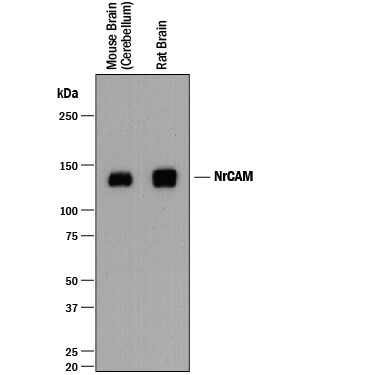Mouse/Rat NrCAM Antibody Summary
Leu30-Pro630
Accession # Q810U4
Applications
Please Note: Optimal dilutions should be determined by each laboratory for each application. General Protocols are available in the Technical Information section on our website.
Scientific Data
 View Larger
View Larger
Detection of Mouse and Rat NrCAM by Western Blot. Western blot shows lysates of mouse brain (cerebellum) tissue and rat brain tissue. PVDF membrane was probed with 1:1000 dilution of Rabbit Anti-Mouse/Rat NrCAM Antigen Affinity-purified Polyclonal Antibody (Catalog # AF8538) followed by HRP-conjugated Anti-Rabbit IgG Secondary Antibody (Catalog # HAF008). A specific band was detected for NrCAM at approximately 104-145 kDa (as indicated). This experiment was conducted under reducing conditions and using Immunoblot Buffer Group 1.
Reconstitution Calculator
Preparation and Storage
- 12 months from date of receipt, -20 °C as supplied.
- 1 month, 2 to 8 °C under sterile conditions after opening.
- 6 months, -20 °C under sterile conditions after opening.
Background: NrCAM
NgCAM related cell adhesion molecule (NrCAM), also known as Bravo, belongs to the L1 family of cell adhesion molecules, which also include L1, neurofascin and close homolog of L1 (CHL-1) (1). These molecules are type I transmembrane proteins that have 6 Ig-like domains and 4‑5 fibronectin type III-like domains in their extracellular domain. They also shared a conserved cytoplasmic region containing an ankyrin-binding site. L1 family cell adhesion molecules are expressed primarily in the nervous system where they share overlapping functions in controlling axonal growth and guidance (1, 2). NrCam mediates homophilic adhesion as well as heterophilic adhesion with a number of neuronal adhesion molecules including contactin, TAG-1/contactin-2, neurofascin and receptor tyrosine phosphatase beta (RPTP beta ) (3‑5). NrCAM has been implicated in the axogenesis of multiple neuronal populations including sensory axons and commissural axons in the spinal cord of chick embryos. It also plays a role in cerebellar granule cell development, and is required in node of Ranvier formation (5, 6).